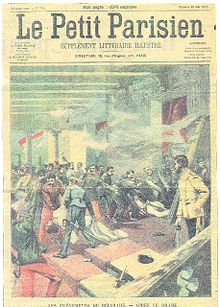
Back Майски преврат в Сърбия Bulgarian Cop de maig Catalan Zavraždění srbské královské rodiny Czech Asesinato de Alejandro I de Serbia Spanish Coup d'État de mai (Serbie) French Asasinato de Alexandre I de Serbia Galician ההפיכה בסרביה (1903) HE Svibanjski prevrat 1903. Croatian Májusi puccs (Szerbia) Hungarian Kudeta Mei (Serbia) ID
You can help expand this article with text translated from the corresponding article in Spanish. (April 2024) Click [show] for important translation instructions.
|
This article needs additional citations for verification. (May 2022) |
 Illustration of the May Coup published in 1903 in the French newspaper Le Petit Parisien | |
| Native name | Мајски преврат, Majski prevrat |
|---|---|
| Date | 10–11 June [O.S. 28–29 May] 1903 |
| Location | Belgrade, Kingdom of Serbia |
| Also known as | May Overthrow |
| Type | Military coup, regicide, assassination |
| Motive | Regime change |
| Target | Stari Dvor, Belgrade |
| Organised by | Dragutin Dimitrijević and other officers |
| Participants | Officer faction within the Royal Serbian Army |
| Outcome | Success
|
| Burial | St. Mark's Church (Royal couple) |
The May Coup (Serbian: Мајски преврат, romanized: Majski prevrat) was a coup d'état in the Kingdom of Serbia which resulted in the assassination of King Alexander I and his consort, Queen Draga, inside the Stari Dvor in Belgrade on the night of 10–11 June [O.S. 28–29 May] 1903. This act resulted in the extinction of the Obrenović dynasty that had ruled Serbia since the middle of the 19th century. A group of Royal Serbian Army officers led by Captain Dragutin Dimitrijević (Apis) organized the assassination. After the May Coup, the throne passed to King Peter I of the Karađorđević dynasty.[1]
Along with the royal couple, the conspirators killed prime minister Dimitrije Cincar-Marković, minister of the army Milovan Pavlović, and general-adjutant Lazar Petrović.[2] The coup had a significant influence on Serbia's relations with other European powers; the Obrenović dynasty had mostly allied with Austria-Hungary, while the Karađorđević dynasty had close ties both with Russia[3] and with France. Each dynasty received ongoing financial support from their powerful foreign sponsors.[4]